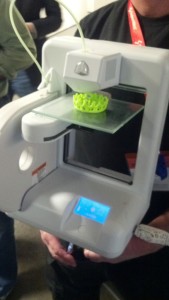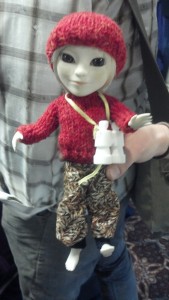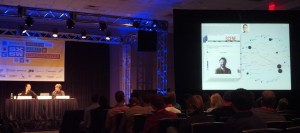 |
| 3D portable printer, big theme at SXSW 2013 |
I attended SXSW Interactive for the fifth time this year. My first South-by was in 2003, when hot topics that year included wikis, blogging, and augmented social networks, and all the panels took place within the confines of the third and fourth floors.
SXSW has come a long way since this, but it’s still a mind-blowing and fun week, full of networking opportunities, chance encounters, amazing speakers, and new technology.
Here are the highlights of this year:
1. 3D Printing is big. No, huge.
Multiple panels covered the topic every day of the conference. 3D printing isn’t just about devices churning out plastic trinkets. It’s about revolutionizing the world of all manufactured objects, in the same way that the moveable type printing press revolutionized printing, and more recently, ebooks and print-on-demand revolutionized the publishing industry.
 |
| Future of 3D Printing Session |
Current state of the art is single-material composites and metals, but coming within a few years we’ll see multi-material printing as well as embedded circuitry.
Although it wasn’t really discussed, one of the big missing aspects of the 3D talks was the topic of an ecosystem play. In the same way that Apple came to dominate the world of music for years, and then later the appstore ecosystem, and in the way Amazon dominates ebooks, there will be the opportunity for someone to own the object-store ecosystem, which will dwarf every other platform out there.
 |
| 3D printed custom doll from Makie |
Some of the things currently being 3D printed include: dolls, clothing, dishes and glasses, plastic items of any design, toys. And in the design labs they are experimenting with: meat, living (and re-attachable) mice limbs, circuitry, and morphable objects.
Panels:
 |
| A Robot in Your Pocket Session |
- Progression
- Analogy: Brakes
- Digital: Antilock
- Robot: Crash avoidance
- Progression
- Analog: thermostat
- Digital: timer thermostat
- Robotic: Nest
- Information
- A: Encyclopedia
- D: Google Search
- R: Google Now
 |
| Self-Publishing in the Age of E Session |
- Democratization of Publishing — an all-star panel, including Libby Johnson Mckee (the Amazon Kindle NA director), Guy Kawasaki (APE), Steve Carpenter (creator Grimm TV show), John Densmore (author, Doors’ drummer)
- Self-Publishing in the Age of E
- They had less total talks. Last year I remember that there were 65 different sessions in a single timeslot. On the plus side, things were more centralized, but on the negative side I heard many stories of people who didn’t get into talks they wanted to. There also wasn’t a journalism/publishing/content track, and perhaps that was one of the things to go.
- There were many more foodcarts around, and for once it was relatively easy to get food between sessions.
- Wireless access was better. I had only a single half hour without access, and that was at the Omni hotel.
- Twitter and Foursquare still in heavy use.
- The bar at the Driskill is still the go-to place for networking in the evening.






